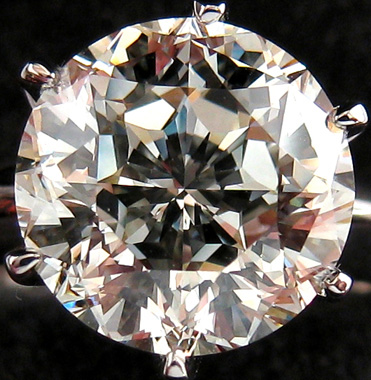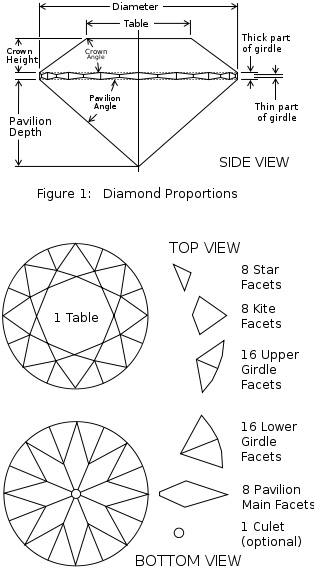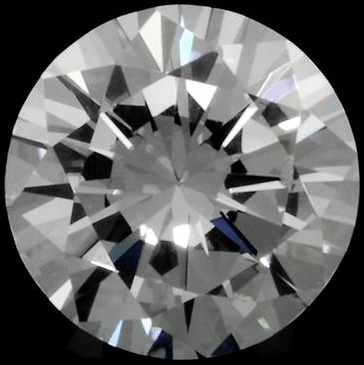Round Cut Diamond
The modern Round Cut diamond or Round Brilliant was developed by diamond cutter Marcel Tolkowsky in 1919. The "standard" round brilliant cut has a total of 58 facets (including culet and not including girdle facets) - with 33 on the crown (1 Table Facet, 8 Star Facets, 8 Kite Facets and 16 Upper Girdle Facets) and 25 on the pavilion (16 Lower Girdle, 8 Pavilion Main, 1 [optional] Culet).
However other round cut designs with other numbers of facets (typically more) have been developed and patented in recent years - such as the 105 facet "Gabrielle" created by Sir Gabriel S.Tolkowsky, great nephew of Marcel Tolkowsky.
Round Cut Diamond History
Marcel Tolkowsky developed his original "Ideal Cut" (also known as the "American Standard") based on complex calculations of the light behavior within a diamond, with the intention of causing the maximum possible return (in both overall amount and beauty) of white and colored light to the observer. If for example the angles of the pavilion are "incorrect", light striking the diamond from above will be "lost" through the bottom half of the stone; whereas if the angles fall within what are called the "ideal" proportions, more of the light (as much as possible) will be returned. This will result in the most brilliance and fire, and the stone itself will appear "whiter".
Tolkowsky's work revolutionized the diamond industry and the round brilliant has since then been widely agreed to be the "most brilliant of all diamond cuts".
Although Marcel Tolkowsky's 58-facet cut became the "industry standard" and one of the most important yardsticks by which modern round brilliants have been graded for the best part of a century, the exact angles and proportions are not universally agreed upon. At least six "ideal cuts" have been developed in the last century, all with variations in Crown height, Pavilion Depth, Table diameter, Girdle thickness, Crown Angle, Pavilion Angle and Brilliance grade. These Ideal Cuts include the Practical Fine Cut (aka Eppler Cut), Scandinavian Standard, Eulitz Brilliant, Ideal Brilliant, Accredited Gem Appraisers (AGA) and Parker Brilliant. [2]
Whichever of the Ideal Cut standards a gem adheres to, it's important to know that Ideal Cut stones are less common in the marketplace than non-ideal gems. One reason for this is that if a stone is cut to ideal proportions, more of the rough must be lost - resulting in a stone with less weight from the same rough gem. Another reason is that the accuracy of the cutter must be higher and that cutting an ideal diamond takes longer. [3] A diamond that is certified with the AGS Ideal ratings for all three categories - polish, symmetry and proportions - is known as a "Triple Ideal Cut". [4]

A 3.17ct "Gabrielle" Round Cut Diamond
Despite these standards of "perfection", Tolkowsky was said to have considered his model to be a guideline, not an absolute rule. Bearing this in mind, it is fascinating to note further recent developments in the science, which, aided by computer technology, have built upon the foundations set by his work.
The first thing to note is that the behavior of light within a diamond may be almost infinitely complex, if not infinitely complex. Tolkowsky "only" calculated the paths of rays of light for the first two reflections within the stone. This is still highly complicated and was advanced for its day. However, due to the high number of facets and angles, variance in the angle at which light strikes them, and the fact that certain rays of light may reflect several times within a stone before "escaping"; actual light performance within a diamond is ultimately considerably more complex than Tolkowsky's Ideal Cut model. [1]
Modern diamond designers have realised that with highly accurate design, cutting and polishing, symmetry and angles in a diamond can be controlled very precisely; and not only can light performance be more predictably "tuned" and maximized, but also that striking optical symmetry and kaliedoscopic-like patterns can be created within the stone. This has led to the creation of many new or enhanced round cut designs of advanced performance in recent years - such as the Hearts and Arrows, Eighternity and Gabrielle cuts. Some of these simply take the 58 cut model and drive it further towards standards of sparkling perfection, using hyper-accurate cutting and polishing techniques. Other modern round cut styles increase the number of facets - and this often has the effect of increasing the scintillation (sparkles and flashes of light seen when the diamond moves). Examples of this are the 91 facet Solasfera Cut, and the Royal 201 Cut, a 201 facet proprietary cut by Dutch diamond company Coster Diamonds.
Choosing diamonds can be highly complex - and it doesn't take long in the marketplace to see that several manufacturers claim that their diamonds are the most brilliant, most perfect, etc. They can't all be right - but one thing they tend to agree on is that ultimately, the purchaser should do their homework, compare a number of stones and choose the one that wins their heart.
Another advantage of the round cut as opposed to fancy cuts (i.e. any other non-round cut diamond) is that they are considered a "safer" shape - i.e. less prone to damage. This increases their insurability.[2]

Above: The facets of a Round Brilliant

Crown view of a Round Brilliant -
photo by Tim van Amstel, rel. under lic. GNU.

See more Diamond cuts
Round Cut Diamond info sources:
[1] http://en.wikipedia.org/wiki/Brilliant_(diamond_cut)
[2] http://en.wikipedia.org/wiki/Diamond_cut
[3] http://www.diamondring.com/forums/diamondtutorial.php?learn=7
[4] http://www.goodoldgold.com/ShapeTutorials/RoundIdealCutDiamonds/
Note - this website is intended for general informational and entertainment purposes, and should not be considered to be professional consultation. If you are considering purchasing precious stones, be sure to seek the advice of a qualified professional.

